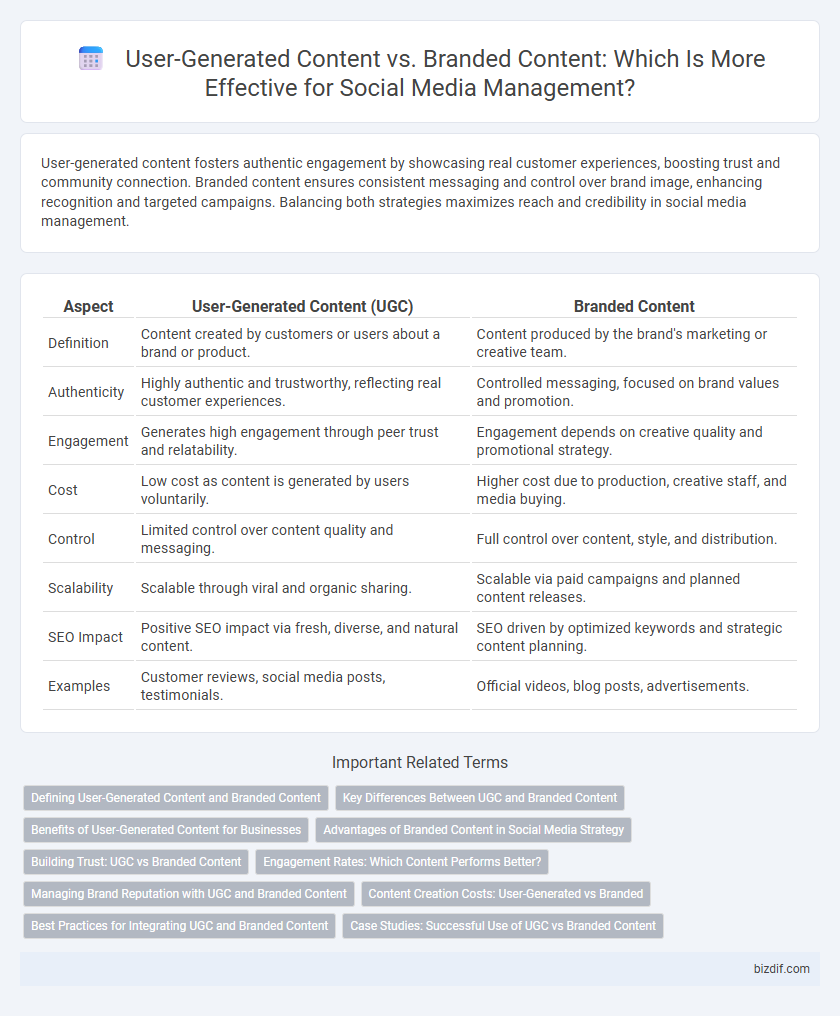User-generated content fosters authentic engagement by showcasing real customer experiences, boosting trust and community connection. Branded content ensures consistent messaging and control over brand image, enhancing recognition and targeted campaigns. Balancing both strategies maximizes reach and credibility in social media management.
Table of Comparison
| Aspect | User-Generated Content (UGC) | Branded Content |
|---|---|---|
| Definition | Content created by customers or users about a brand or product. | Content produced by the brand's marketing or creative team. |
| Authenticity | Highly authentic and trustworthy, reflecting real customer experiences. | Controlled messaging, focused on brand values and promotion. |
| Engagement | Generates high engagement through peer trust and relatability. | Engagement depends on creative quality and promotional strategy. |
| Cost | Low cost as content is generated by users voluntarily. | Higher cost due to production, creative staff, and media buying. |
| Control | Limited control over content quality and messaging. | Full control over content, style, and distribution. |
| Scalability | Scalable through viral and organic sharing. | Scalable via paid campaigns and planned content releases. |
| SEO Impact | Positive SEO impact via fresh, diverse, and natural content. | SEO driven by optimized keywords and strategic content planning. |
| Examples | Customer reviews, social media posts, testimonials. | Official videos, blog posts, advertisements. |
Defining User-Generated Content and Branded Content
User-generated content (UGC) refers to any form of content, such as photos, videos, reviews, or posts, created and shared by consumers or followers rather than brands. Branded content is professionally produced material created by companies to promote their identity, products, or services while maintaining a narrative aligned with their marketing goals. UGC fosters authentic engagement and trust, whereas branded content ensures consistent messaging and brand control.
Key Differences Between UGC and Branded Content
User-generated content (UGC) is created by customers or fans, showcasing authentic experiences and fostering trust, while branded content is produced by companies to promote products or services with controlled messaging. UGC often drives higher engagement and social proof due to its relatable nature, whereas branded content offers strategic brand storytelling and consistent quality. Understanding these key differences helps businesses balance authenticity with brand voice in their social media management strategies.
Benefits of User-Generated Content for Businesses
User-generated content (UGC) drives higher engagement rates by leveraging authentic customer experiences, fostering trust and community around a brand. Businesses benefit from increased social proof, as UGC acts as organic endorsements that boost conversion rates and customer loyalty. Moreover, UGC reduces content creation costs while expanding reach through diverse user networks on platforms like Instagram, TikTok, and Facebook.
Advantages of Branded Content in Social Media Strategy
Branded content enhances social media strategies by delivering consistent brand messaging that strengthens brand identity and loyalty. It offers greater control over the narrative, ensuring content aligns with marketing goals and resonates with target audiences. This approach also allows for precise performance tracking and optimization through analytics, improving campaign effectiveness and return on investment.
Building Trust: UGC vs Branded Content
User-generated content (UGC) enhances trust by offering authentic, relatable experiences from real customers, which fosters genuine engagement. Branded content, while polished and consistent with brand messaging, may be perceived as less credible due to its promotional nature. Leveraging UGC in social media management boosts credibility and builds stronger consumer trust compared to solely relying on branded content.
Engagement Rates: Which Content Performs Better?
User-generated content (UGC) consistently achieves higher engagement rates compared to branded content, often generating up to 28% more interaction from audiences. Authenticity and relatability in UGC foster trust and encourage likes, shares, and comments more effectively than traditional branded posts. Brands leveraging UGC in social media strategies can significantly enhance user engagement and community growth.
Managing Brand Reputation with UGC and Branded Content
User-generated content (UGC) enhances brand authenticity by showcasing real customer experiences, fostering trust and engagement. Branded content allows precise control over messaging and visual identity, ensuring consistent brand reputation across platforms. Balancing UGC with branded content empowers social media managers to harness genuine customer advocacy while maintaining professional brand standards.
Content Creation Costs: User-Generated vs Branded
User-generated content significantly reduces content creation costs by leveraging authentic posts from customers and followers, eliminating the need for expensive production resources. Branded content, while more controlled and polished, requires investment in professional design, copywriting, and advertising, increasing overall expenses. Balancing these approaches helps businesses optimize budgets while maintaining a strong and credible social media presence.
Best Practices for Integrating UGC and Branded Content
To maximize engagement in social media management, strategically blend user-generated content (UGC) with branded content by showcasing authentic customer experiences alongside polished brand messages. Prioritize featuring UGC that aligns with brand values and quality standards to build trust, while using branded content to reinforce brand identity and key campaigns. Employ clear calls to action and consistent visual branding to create a cohesive narrative that encourages user interaction and amplifies brand loyalty.
Case Studies: Successful Use of UGC vs Branded Content
User-generated content (UGC) drives engagement by fostering authentic community interactions, as demonstrated by Starbucks' #RedCupContest, which boosted brand visibility through customer-shared holiday photos. Branded content, exemplified by Nike's expertly crafted "Dream Crazy" campaign, delivers impactful storytelling that reinforces brand identity and inspires audiences. Case studies reveal UGC excels in trust and organic reach, while branded content excels in controlled messaging and brand consistency.
User-generated content vs Branded content Infographic

 bizdif.com
bizdif.com